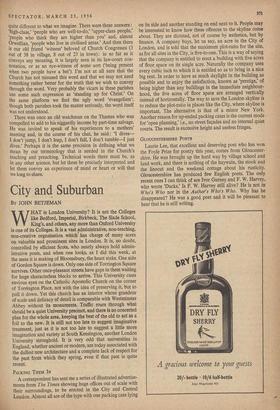City and Suburban
BY JOHN BETJEMAN WHAT is London University? It is not the Colleges like Bedford, Imperial, Birkbeck, The Slade School, King's, and others, any more than Oxford University is one of its Colleges. It is a vast administrative, non-teaching, non-creative organisation which' has charge of many acres on valuable and prominent sites in London. It is, no doubt, controlled by efficient Scots, who nearly always hold admin- istrative posts, and when one looks, as I did this week, at the mess it is making of Bloomsbury, the heart sinks. One side of Gordon Square is down. Only one side of Torrington Square survives. Other once-pleasant streets have gaps in them waiting for huge characterless blocks to arrive. This University casts envious eyes on the Catholic Apostolic Church on the corner of Torrington Place, not with the idea of preserving it, but to pull it down. Yet this church has an interior whose grandeur of scale and delicacy of detail is comparable with Westminster Abbey without its monuments. Traffic roars through what should be a quiet University precinct, and there is no concerted plan for the whole area, keeping the best of the old to act as a foil to the new. It is still not too late to suggest imaginative treatment, just as it is not too late to suggest a little more imagination and variety at South Kensington, another London University stronghold. It is very odd that universities in England, whether ancient or modern, are today associated with the dullest new architecture and a complete lack of respect for the past from which they spring, even if that past is quite recent.
PACKING THEM IN
A correspondent has sent me a series of illustrated advertise- ments from The Times showing huge offices out of scale with their surroundings, to be erected in the City and Central London. Almost all are of the type with one packing case lying on its side and another standing on end next to it. People may be interested to know how these offences to the skyline come about. They are dictated, not of course by esthetics, but by finance. A company buys, let us say, an acre in the City of London, and is told that the maximum plot-ratio for the site, as for all sites in the City, is five-to-one. This is a way of saying that the company is entitled to erect a building with five acres of floor space on its single acre. Naturally the company uses every cubic inch to which it is entitled so as to bring in a nice big rent. In order to have as much daylight in the building as possible and to enjoy the satisfaction, known as 'prestige,' of being higher than any buildings in the immediate neighbour- hood, the five acres of floor spice are arranged vertically instead of horizontally. The way to save the London skyline is to reduce the plot-ratio in places like the City, where skyline is important. The alternative is that of a minor New York. Another reason for up-ended packing cases is the current mode for 'open planning,' i.e., no street facades and no internal quiet courts. The result is excessive height and useless fringes.
GLOUCESTERSHIRE POETS
Laurie Lee, that excellent and deserving poet who has won the Foyle Prize for poetry this year, comes from Gloucester- shire. He was brought up the hard way by village school and land work, and there is nothing of the haywain, the stook and the linocut and the weekend cottage about his rusticity. Gloucestershire has produced few English poets. The only recent ones I can think of are Ivor Gurney and F. W. Harvey, who wrote 'Ducks.' Is F. W. Harvey still alive? He is not in Who's Who nor in the Author's Who's Who. Why has he disappeared? He was a good poet and it will be pleasant to hear that he is still writing.


































 Previous page
Previous page